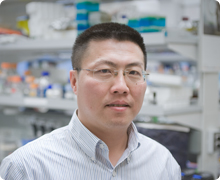Yu Lab
Studying How Craniofacial Malformations Develop
 Craniofacial malformations can be caused by abnormal genes, environmental factors or a combination of the two. Dr. Kai Yu uses mouse models and human embryonic tissues to study how these malformations occur, opening the door to new ways to diagnose, prevent and treat them.
Craniofacial malformations can be caused by abnormal genes, environmental factors or a combination of the two. Dr. Kai Yu uses mouse models and human embryonic tissues to study how these malformations occur, opening the door to new ways to diagnose, prevent and treat them.
Cleft palate: Analyzing molecular and cellular mechanisms of palatogenesis
Approximately one in 1,000 children is born with a cleft palate, making it one of the most common craniofacial conditions.
In mammals, the secondary palate is formed when two separate palatal shelves fuse. After initial vertical growth on either side of the tongue, these palatal shelves undergo an elevation process and move into a horizontal position above the tongue. There, the opposing shelves approximate each other for contact and fusion. If the shelves don’t elevate or fuse properly, it slows or stops the secondary palate from closing. This creates a cleft palate.
Our lab is studying this process to better understand how and why cleft palate develops. We are using mouse models to determine the roles of mesenchymal hyaluronic acid (HA) and fibroblast growth factor receptor (FGFR) signaling during palatal shelf elevation. Our research will try to determine if palatal shelf elevation in humans and mice involve a similar molecular and cellular mechanism. We also aim to to use the gene expression profile to define molecular regulation of regional heterogeneity in the developing mouse and human palate.
To achieve these aims, we use mouse genetics, state-of-the-art 3D tomographic imaging technology, immunohistochemistry, in situ hybridization and qPCR to examine gene expression, cellular changes and tissue interactions during secondary palate closure in mice and humans. We hope our findings will contribute to methods that promote secondary palate closure and prevent cleft palate in children.
Robin sequence: Analyzing tissue interactions during orofacial development
Robin sequence (RS) is a human congenital disorder characterized by an unusually small mandible (micrognathia), posterior displacement of the tongue (glossoptosis) and high incidence of cleft palate. Abnormal tongue position also leads to life-threatening airway obstruction and substantial morbidity, and even mortality, in infants and young children. RS is etiologically heterogeneous and can be seen in isolation or in combination with many human syndromes.
Syndromic and non-syndromic RS are caused when the gene SOX9 is dysregulated. Despite of the presence of multiple orofacial anomalies, RS is not considered to be a syndrome. Rather, it’s seen as a sequence in which orofacial anomalies result from a sequential chain of dysregulated morphogenetic events.
We are studying the causes and development of RS. Our research analyzes physical interactions between the tongue and other orofacial structures to determine if dysregulation of these interactions results in RS anomalies. One of our goals is to determine SOX9’s role in regulating how the palatal shelves grow and move.
To achieve these aims, we use mouse genetics, histology, immunohistochemistry, in situ hybridization and state-of-the-art 3D tomographic imaging technology. This helps us identify molecular, cellular and morphogenetic changes in mutant mice that have either lower jaw defects or palatal shelf defects. It may also help us further define the roles of dysregulation of lower jaw and palatal shelf growth in pathogenesis of RS.
We hope to bridge the gap between animal models and clinical studies. This would significantly advance our understanding of etiology and pathogenesis of RS in humans, which is essential for prevention, diagnosis and guiding treatment interventions.
Publications
Visit PubMed for a complete list of Yu’s publications.
Investigator Biography
Kai Yu, PhD, is a research assistant professor in the Department of Pediatrics at the University of Washington School of Medicine and a member of the Seattle Children's Research Institute's Center for Developmental Biology and Regenerative Medicine.
